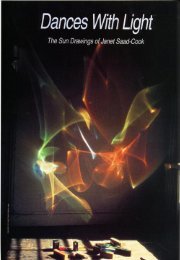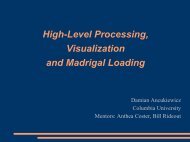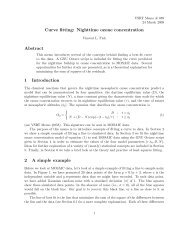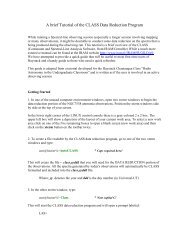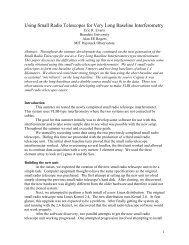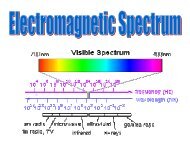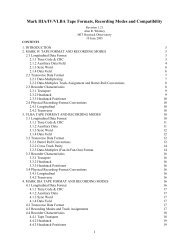MARK 5 MEMO #039 - MIT Haystack Observatory
MARK 5 MEMO #039 - MIT Haystack Observatory
MARK 5 MEMO #039 - MIT Haystack Observatory
You also want an ePaper? Increase the reach of your titles
YUMPU automatically turns print PDFs into web optimized ePapers that Google loves.
<strong>MARK</strong> 5 <strong>MEMO</strong> <strong>#039</strong>MASSACHUSETTS INSTITUTE OF TECHNOLOGYHAYSTACK OBSERVATORYWESTFORD, MASSACHUSETTS 0188621 June 2006Telephone: 978-692-4764Fax: 781-981-0590TO:FROM:SUBJECT:Mark 5 groupAlan R. WhitneyMark 5A+ playback modes with Mark 5B recordingsThe Mark 5A+ is a ‘compatibility’ extension of the Mark 5A Xilinx code to allow playback ofrecordings made with Mark 5B. The output of the Mark 5A+ is standard VLBA-format output‘tracks’ that can be correlated on Mark 4 or VLBA correlators with Mark 5A+ playback units.Playback modes of Mark 5A disks are unaffected.Operating modesTable 1 shows the ‘compatibility’ modes supported by Mark 5A+. Each Mark 5B bit-stream is asign or magnitude bit stream at the sample rate.# Mk5Brecorded DIMbit-streamsTrack mappingFanout ratio toVLBA-format tracks#outputVLBA tracks#Mark5B diskframes per VLBAtrack frameReferenceFigure#in this memoReferenceTable #in this memo2 4 8 2 1 34 2 8 2 1 48 1 8 2 1 54 4 16 4 2 48 2 16 4 2 516 1 16 4 2 68 4 32 8 3 516 2 32 8 3 632 1 32 8 3 716 4 64 16 4 632 2 64 16 4 7Table 1: ‘Compatibility’ modes implemented in Mark 5A+.The mapping from baseband-channel sign and magnitude bit-streams to Mark 5B bit-streams isdetailed in Table 2 for the Mark 4 VSI formatter and the Metsahovi VSI-C board. When playedback on the Mark 5A+, each of the Mark 5B bit-streams are reconstructed into 1, 2 or 4 VLBAformattracks (‘fanout’) according to operator instruction.039.doc 6/22/2006 1
The detailed mapping of these bit-streams to track numbers is, of course, important for properlysetting up for correlation. Unfortunately, no single track mapping from the Mark 5B bit streamsto VLBA output tracks results in track assignments that can be accommodated at all correlators,most particularly the VLBA correlator, which expects particular track ordering. Therefore, inaddition to the default track mapping, additional optional mappings are provided to deal with thisissue. Figures 1 through 4 show the available mappings from Mark 5B 32-bit data words tooutput tracks for each of these cases of 8, 16, 32 and 64 output tracks, respectively. In each case,Map 0 is the mapping used by normal Mark 5A operation, while the other maps are speciallydesigned for Mark 5A+ to accommodate VLBA-correlator requirements. Tables 3 through 7show the resulting track assignments as a function of the number of recorded Mark 5B bitstreams, the VLBA fan-out ratio, and the selection of the track mapping option. Table 8 showsthe recommended track mapping option as a function of the number of Mark 5B bit-streams andthe number of playback tracks; these values should always be used except for testing orextraordinary circumstances.Generation of VLBA tape framesOn startup, the Mark 5A+ waits for the first Mark 5B disk-frame number evenly divisible by 16and starts generating VLBA tape frames from that point. This guarantees that the VLBA tapeframe will be properly registered to the Mark 5B data. The VLBA-format time-code in the Mark5B Disk Frame Header is used directly to generate the time-code in the corresponding VLBAtape track frame headers. The auxiliary-data field in all VLBA tape frame headers for all tracksgenerated by Mark 5A+ is identically zero.Data invalidationThe Mark 5A+ keeps a continuous eye open for the Mark 5B fill pattern, which marks invaliddata. If fill pattern is recognized, the data in all VLBA output tracks are marked invalid byinverting the data parity bit in exactly the same manner that the Mark 5A manages invalid data.Support of correlation modes at VLBA correlatorTable 9 lists the most commonly used VLBA recording modes (provided courtesy of JonRomney) as well as other modes recorded with Mark 4 formatters. All of the most commonlyused VLBA mode, plus a number of additional modes, are supported by Mark 5A+ with outputtrack mappings compatible with the VLBA correlator.Mark 5A+ usageIn order to play Mark 5B data on the Mark 5A+ system, you must first know two importantpieces of information: 1) the number of bit-streams recorded on the Mark 5B recording, and2) the number of VLBA tracks you wish to create in the playback (equivalent to fanout ratio).Then, using Table 8, determine the recommended track-map option, designated m. Playback ofMark 5B data on the Mark 5A+ system is setup by the ‘mode=’ command:mode = mark5a+m : #tracks (example: ‘mode = mark5a+2 : 32’);For example, to play a Mark 5B recording with 16 recorded bit-streams fanned out to 32 VLBAformattracks, Table 8 recommends m=2. Thereafter, playback is managed in the same way asfor a standard Mark 5A recording. Of course, the proper track mappings must be specified in thecorrelator control files. The ‘mode’ must be set before queries such as ‘scan_check?’ and‘track_check?’ are used. Furthermore, care must be exercised since some of the returned039.doc 6/22/2006 2
parameters may be different; for example, there will be no track numbers returned by‘track_check?’ since the Mark 5A+ sets the auxiliary data field identically to zero.310t3t2t1t0Map 0 1 22 2 24 10 66 4 108 12 1410 6 412 14 814 8 1216 16 16Figure 1: Mapping of bits in FPDP word to tracks for all cases of 8 output tracks; 3 mapping options are available.Output track groups are duplicated in the same manner as Mark 5A. t 0 –t 3 refer to output-track clock cycles.310Map 024121022668182610141012141618412202861822263042022241422308121626283032816243220242832t1t0Figure 2: Mapping of bits in FPDP word to tracks for all cases of 16 output tracks; 3 mapping options are available.Output track groups are duplicated in the same manner as Mark 5A. t 0 –t 1 refer to output-track clock cycles.039.doc 6/22/2006 3
310Map 0 12 23 104 185 266 37 118 199 2710 411 1212 2013 2814 515 1316 2117 2918 619 1420 2221 3022 723 1524 2325 3126 827 1628 2429 3230 931 1732 2533 33t0Figure 3: Mapping of bits in FPDP word to tracks for all cases of 32 output tracks; 3 mapping options are available.Headstack 1 output is duplicated to Headstack 2 (as in Mark 5A). t 0 refers to a single output-track clock cycle.226101418222630371115192327314812162024283259131721252933039.doc 6/22/2006 4
31FPDP 1031FPDP 00Map 0 12 23 104 185 266 37 118 199 2710 211 1012 1813 2614 315 1116 1917 2718419 1220 2021 2822523 1324 2125 2926427 1228 2029 2830531 1332 2133 292 63 144 225 306 77 158 239 3110 611 1412 2213 3014 715 1516 2317 3118 819 1620 2421 3222 923 1724 2525 3326 827 1628 2429 3230 931 1732 2533 33Headstack 1 Headstack 2Headstack 1Headstack 2 Headstack 1 Headstack 2 Headstack 1Headstack 2 Headstack 1Headstack 222610141822263037111519232731261014182226303711151923273148121620242832591317212529334812162024283259131721252933Headstack 1Headstack 2 Headstack 1Headstack 2t0Figure 4: Mapping of bits in two consecutive FPDP words to output tracks for all cases of 64 output tracks;3 mapping options are available. t 0 refers to a single output-track clock cycle.039.doc 6/22/2006 5
Mark 5Bbit-stream #Mk4 VSIformatterVSI1 output VSI1 output VSI2 output‘Astronomy’ ‘Geodesy’ Allmode mode modes0 1US 1US 9US 1US1 1UM 1UM 9UM 1UM2 2US 2US 10US 2US3 2UM 2UM 10UM 2UM4 3US 3US 11US 3US5 3UM 3UM 11UM 3UM6 4US 4US 12US 4US7 4UM 4UM 12UM 4UM8 5US 5US 13US 5US9 5UM 5UM 13UM 5UM10 6US 6US 14US 6US11 6UM 6UM 14UM 6UM12 7US 7US - 7US13 7UM 7UM - 7UM14 8US 8US - 8US15 8UM 8UM - 8UM16 1LS 1LS 9LS 1LS17 1LM 1LM 9LM 1LM18 2LS 8LS 10LS 2LS19 2LM 8LM 10LM 2LM20 3LS 9US 11LS 3LS21 3LM 9UM 11LM 3LM22 4LS 10US 12LS 4LS23 4LM 10UM 12LM 4LM24 5LS 11US 13LS 5LS25 5LM 11UM 13LM 5LM26 6LS 12US 14LS 6LS27 6LM 12UM 14LM 6LM28 7LS 13US - 7LS29 7LM 13UM - 7LM30 8LS 14US - 8LS31 8LM 14UM - 8LMMetsahoviVSI-C boardTable 2: Mapping of baseband-channel sample streams to Mark 5B bit-streams for both Mark 4 VSI formatter(modified Mark 4 formatter) and the Metsahovi VSI-C board connected to VLBA samplers.[Example: ‘4UM’ is BBC4, USB, magnitude]039.doc 6/22/2006 6
Mk5Bbit-stream#Fanout 1(16 output tracks)Fanout 2(32 output tracks)Fanout 4(64 output tracks) [hdstk]Map 0 Map 1 Map 2 Map 0 Map 1 Map 2 Map 0 Map 10 2 2 2 2,18 2,6 2,4 2,18[1], 2,18[2] 2,4,6,8[1]1 4 10 6 3,19 10,14 6,8 3,19[1], 3,19[2] 10,12,14,16[1]2 6 18 10 4,20 18,22 10,12 4,20[1], 4,20[2] 18,20,22,24[1]3 8 26 14 5,21 26,30 14,16 5,21[1], 5,21[2] 26,28,20,32[1]4 10 4 18 6,22 3,7 18,20 6,22[1], 6,22[2] 3,5,7,9[1]5 12 12 22 7,23 11,15 22,24 7,23[1], 7,23[2] 11,13,15,17[1]6 14 20 26 8,24 19,23 26,28 8,24[1], 8,24[2] 19,21,23,25[1]7 16 28 30 9,25 27,31 30,32 9,25[1], 9,25[2] 27,29,31,33[1]8 18 6 4 10,26 4,8 3,5 10,26[1], 10,26[2] 2,4,6,8[2]9 20 14 8 11,27 12,16 7,9 11,27[1], 11,27[2] 10,12,14,16[2]10 22 22 12 12,28 20,24 11,13 12,28[1], 12,28[2] 18,20,22,24[2]11 24 30 16 13,29 28,32 15,17 13,29[1], 13,29[2] 26,28,20,32[2]12 26 8 20 14,30 5,9 19,21 14,30[1], 14,30[2] 3,5,7,9[2]13 28 16 24 15,31 13,17 23,25 15,31[1], 15,31[2] 11,13,15,17[2]14 30 24 28 16,32 21,25 27,29 16,32[1], 16,32[2] 19,21,23,25[2]15 32 32 32 17,33 29,33 31,33 17,33[1], 17,33[2] 27,29,31,33[2]Table 6: Track mapping options for playback of recordings with 16 Mark 5B bit-streams. Recommended mappingsare shaded and are compatible with track mappings required by VLBA correlator.039.doc 6/22/2006 8
#output tracksfanout ratio#Mk5B bit-streams 8 16 32 64 1 2 42 1 - - - - - 14 2 1 - - - 2 18 0 2 1 - 0 2 116 - 0 2 1 0 2 132 - - 2 2 2 2 -Table 8: Recommended Mark 5A+ track-mapping option as a function of the number of recorded Mark 5B DIMinput bit-streams and # of output tracks or fanout ratio (i.e. #output-trks/#bit-streams). All recommended trackmappings except the case of 32 bit-streams played back to 32 tracks (fanout ratio 1) are compatible with trackmappings required by the VLBA correlator. All recommended track mappings are compatible with the Mark 4correlators.MostcommonVLBAmodesTotal(Mbps)#chns b/s Total BW(MHz)SampleRate(Ms/s)TrackRate(Mbps)#Mark5Bbitstreams#tracksFan-Out(tks/bitstream)Mk5A+trk mapoptionVLBAUsageOtherusage256-8-2 256 8 2 64 16 8 16 32 2 2 39.3%128-8-1 128 8 1 64 16 4 8 32 4 1 17.0% RDV128-4-2 128 4 2 32 16 4 8 32 4 1 17.0%256-4-2 256 4 2 64 32 8 8 32 4 1 5.4%128-8-2 128 8 2 32 8 4 16 32 2 2 4.9%64-2-2 64 2 2 16 16 4 4 16 4 1 2.4%128-4-2 128 4 2 32 16 8 8 16 2 2 1.8%128-4-1 128 4 1 64 32 8 4 16 4 1 1.8%128-2-2 128 2 2 32 32 8 4 16 4 1 1.8%128-8-2 128 8 2 32 8 8 16 16 1 0 1.5%32-8-2 32 8 2 8 2 2 16 16 1 0 1.5%64-4-2 64 4 2 16 8 4 8 16 2 2 1.3%16-4-2 16 4 2 4 2 2 8 8 1 0 1.3%512-8-2 512 8 2 128 32 8 16 64 4 1 1.1%64-8-1 64 8 1 32 8 2 8 32 4 1 0.6%32-1-2 32 1 2 8 16 4 2 8 4 1 0.5%128-8-1 128 8 1 64 16 8 8 16 2 2 0.3%64-8-2 64 8 2 16 4 4 16 16 1 0 0.3%512-16-1 512 16 1 256 32 8 16 64 4 1 0.2%Other modes1024-16-2 1024 16 2 256 32 16 32 64 2 2 R&D512-16-1 512 16 1 256 32 16 16 32 2 2512-16-2 512 16 2 128 16 16 32 32 1 2512-16-2 512 16 2 256 16 8 32 64 2 2256-16-1 256 16 1 128 16 8 16 32 2 2 R1128-16-1 128 16 1 64 8 8 16 16 1 0 R4Table 9: List of most commonly used recording modes, listing the Mark5A+ track mapping option to be used witheach mode (shaded). The most commonly used VLBA modes are for the period 2005.01.01 to 2006.04.07(provided courtesy Jon Romney, NRAO). Note that some recording modes can be supported with more than onefan-out value (i.e. 512-16-2); the track mapping option changes if a different fan-out value is used.039.doc 6/22/2006 10




